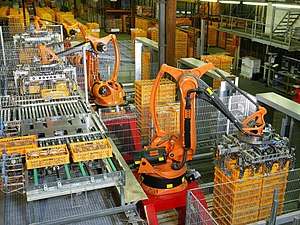Food engineering
Food engineering is a multidisciplinary field which combines microbiology, applied physical sciences, chemistry and engineering for food and related industries. Food engineering includes, but is not limited to, the application of agricultural engineering, mechanical engineering and chemical engineering principles to food materials. Food engineers provide the technological knowledge transfer essential to the cost-effective production and commercialization of food products and services. Physics, chemistry, and mathematics are fundamental to understanding and engineering products and operations in the food industry.[1]

Food engineering encompasses a wide range of activities. Food engineers are employed in food processing, food machinery, packaging, ingredient manufacturing, instrumentation, and control. Firms that design and build food processing plants, consulting firms, government agencies, pharmaceutical companies, and health-care firms also employ food engineers. Specific food engineering activities include:
- drug/food products;
- design and installation of food/biological/pharmaceutical production processes;
- design and operation of environmentally responsible waste treatment systems;
- marketing and technical support for manufacturing plants.
Topics
In the development of food engineering, one of the many challenges is to employ modern tools, technology, and knowledge, such as computational materials science and nanotechnology, to develop new products and processes. Simultaneously, improving quality, safety, and security remain critical issues in food engineering study. New packaging materials and techniques are being developed to provide more protection to foods, and novel preservation technology is emerging. Additionally, process control and automation regularly appear among the top priorities identified in food engineering. Advanced monitoring and control systems are developed to facilitate automation and flexible food manufacturing. Furthermore, energy saving and minimization of environmental problems continue to be important food engineering issues, and significant progress is being made in waste management, efficient utilization of energy, and reduction of effluents and emissions in food production.
Typical topics include:
- Advances in classical unit operations in engineering applied to food manufacturing
- Progresses in the transport and storage of liquid and solid foods
- Developments in heating, chilling and freezing of foods
- Advanced mass transfer in foods
- Advances in cleaning and sanitation
- Low moisture content foods
- New chemical and biochemical aspects of food engineering and the use of kinetic analysis
- Process design and development of various alternative nonthermal food preservation methods[2] using lethal agents such as high pressure[3], pulsed electric field[4], UV[5], ultrasound[6], ozone[7] and cold plasma.[8]
- New techniques in dehydration, thermal processing, extrusion, liquid food concentration, membrane processes and applications of membranes in food processing
- Shelf-life, electronic indicators in inventory management, and sustainable technologies in food processing
- Modern packaging, cleaning, and sanitation technologies.
- Development of sensors systems for quality [9][10] and safety assessment [11][12][13][14]
See also
- Cosmetics
- Pharmaceuticals
- Food science
- Food technology
- Aseptic processing
- Dietary supplement
- Food and biological process engineering
- Food fortification
- Food preservation
- Food rheology
- Food supplements
- Future food technology
- Nutraceutical
- Nutrification (aka food enrichment or fortification)
- Food and bioprocess technology
- Food safety
- Food chemistry
- Food physical chemistry
References
- Singh , R Paul; Dennis R. Heldman (2013). Introduction to Food Engineering (5th ed.). Academic Press. p. 1. ISBN 978-0123985309.
- Howard Q. Zhang Gustavo V. Barbosa‐Cánovas V.M. Balasubramaniam C. Patrick Dunne Daniel F. Farkas James T.C. Yuan (2011). Nonthermal Processing Technologies for Food. Newyork: Wiley. ISBN 9780470958360.
- Balasubramaniam, V.M., Barbosa-Cánovas, Gustavo V., Lelieveld, Huub L.M. (2016). High Pressure Processing of Food Principles, Technology and Applications. Springer. ISBN 978-1-4939-3234-4.CS1 maint: multiple names: authors list (link)
- Gustavo V. Barbosa-Canovas, Q. Howard Zhang. Pulsed Electric Fields in Food Processing: Fundamental Aspects and Applications. Taylor & Francis. ISBN 9781566767835.
- Tatiana Koutchma, Larry J. Forney, Carmen I. Moraru (2019). Ultraviolet Light in Food Technology: Principles and Applications. CRC Press. ISBN 9780367385934.CS1 maint: multiple names: authors list (link)
- Hao FengGustavo Barbosa-CanovasJochen Weiss (2011). Ultrasound Technologies for Food and Bioprocessing. Springer.
- Colm O'Donnell B. K. Tiwari P. J. Cullen Rip G. Rice (2012). Ozone in Food Processing. Blackwell Publishing Ltd. ISBN 9781118307472.
- NN Misra, Oliver Schlüter, PJ Cullen. Cold Plasma in Food and Agriculture: Fundamentals and Applications. Elsevier. ISBN 978-0128013656.CS1 maint: multiple names: authors list (link)
- García, MR; Cabo, ML; Herrera, JR; Ramilo-Fernández, G; Alonso, AA; Balsa-Canto, E (March 2017). "Smart sensor to predict retail fresh fish quality under ice storage". Journal of Food Engineering. 197: 87–97. doi:10.1016/j.jfoodeng.2016.11.006. hdl:10261/141204.
- García, MR; Vilas, C; Herrera, JR; Bernárdez, M; Balsa-Canto, E; Alonso, AA (2 September 2015). "Quality and shelf-life prediction for retail fresh hake (Merluccius merluccius)". International Journal of Food Microbiology. 208: 65–74. doi:10.1016/j.ijfoodmicro.2015.05.012. PMID 26058006.
- Mabrook, M.F.; Petty, M.C. (2003). "Effect of composition on the electrical conductance of milk". Journal of Food Engineering. 60 (3): 321–325. doi:10.1016/S0260-8774(03)00054-2.
- Damez, J.L.; Clerion, S.; Abouelkaram, S.; Lepetit, J. (2008). "Beef meat electrical impedance spectroscopy and anisotropy sensing for non-invasive early assessment of meat ageing". Journal of Food Engineering. 85 (1): 116–122. doi:10.1016/j.jfoodeng.2007.07.026.
- Rehman, M.; Abu Izneid, J.A.; Abdullha, M.Z.; Arshad, M.R. (2011). "Assessment of quality of fruits using impedance spectroscopy". International Journal of Food Science & Technology. 46 (6): 1303–1309. doi:10.1111/j.1365-2621.2011.02636.x.
- Harker, F.R.; Forbes, S.K. (1997). "Ripening and development of chilling injury in persimmon fruit: An electrical impedance study". New Zealand Journal of Crop and Horticultural Science. 25 (2): 149–157. doi:10.1080/01140671.1997.9514001.
